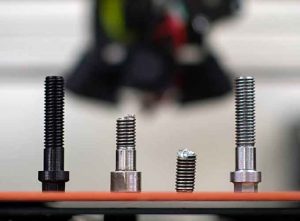 3D printing has become a bigger part of life in the United States Navy, and indeed in all branches of the military, as servicepeople come up with ingenious ways to use the technology to save time and money and overall make life easier. Last month, the USS Chung-Hoon Arleigh Burke-class guided-missile destroyer ran into some trouble when a bolt from a hangar bay roller assembly became stressed to the point of breaking. The damaged bolt meant that the door could not open and close properly. Instead of being able to replace one simple part, the Chung-Hoon would need to order an entirely new roller assembly, which the ship didn’t have time to wait for.
3D printing has become a bigger part of life in the United States Navy, and indeed in all branches of the military, as servicepeople come up with ingenious ways to use the technology to save time and money and overall make life easier. Last month, the USS Chung-Hoon Arleigh Burke-class guided-missile destroyer ran into some trouble when a bolt from a hangar bay roller assembly became stressed to the point of breaking. The damaged bolt meant that the door could not open and close properly. Instead of being able to replace one simple part, the Chung-Hoon would need to order an entirely new roller assembly, which the ship didn’t have time to wait for.
Luckily, the Chung-Hoon was close to another ship: the Nimitz-class aircraft carrier USS John C. Stennis, whose machine shop had a 3D printer installed by Naval Sea Systems Command in April as part of a Deputy Chief of Naval Operations for Fleet Readiness and Logistics (OPNAV N4) additive manufacturing acceleration initiative.
When the John C. Stennis’ Chief Engineer, Cmdr. Kenneth Holland, received the request for a new bolt from the Chung-Hoon, he saw it as a great opportunity to test out the capabilities of the new 3D printer.
“The printers are being used right now to resolve issues while they’re small problems,” said Holland. “It’s used to help manufacture parts that you can generally only get if you buy the higher assembly.”
 Machinery Repariman 1st Class Clinton Barlow received the broken bolt from the Chung-Hoon, who designed a new part using CAD software. Before he could create a new part, however, he and his team had to be trained in the use of the new 3D printer.
Machinery Repariman 1st Class Clinton Barlow received the broken bolt from the Chung-Hoon, who designed a new part using CAD software. Before he could create a new part, however, he and his team had to be trained in the use of the new 3D printer.
“Representatives from NAVSEA came out to sea with us during one of our recent underways and helped teach us how to use the printers,” said Machinery Repairman 3rd Class Blaine Matthews. “This was on top of the one-day training that we received in Keyport that got us familiarized with the equipment. When they came underway with us, it was our chance to get the machines dirty and see what they were made of.”
Once he had been trained, Barlow 3D printed a replica of the bolt and sent it back to the Chung-Hoon so that they could test it and make sure it met the requirements of the door. After that replica was approved, a new bolt could be made using conventional metal machining technology.
“We can replicate that bolt, send it to the ship, ask if it fits length wise, thread wise, and is this what you guys need us to make,” said Barlow. “Instead of spending the time of cutting all that metal away, which can take up to six hours to do, I can print one and make the changes on the go. It saves time and it saves money.”
Holland and his team have 3D printed several other small but important parts for other Navy colleagues, as well.
“For example, one of AIMD’s (Aviation Intermediate Maintenance Department) calibration machines didn’t work because they didn’t have any knobs for it,” said Holland. “We were able to manufacture a simple plastic knob and by creating that knob, although small, we were able to get that machine back up and running.”
The 3D printed part saved a significant amount of money for the department.
“They would’ve had to order a brand-new console which would’ve cost $5,300,” said Barlow. “They brought me the knob, I designed it, put it on there and now they can use that piece of equipment which they use for hundreds of calibrations. They could’ve spent $5,300 on a new system or the six cents of material that it took to make that knob.”
Holland and his team are constantly looking for ways that they can use 3D printing to save money and time.
“It gives us another effective tool to keep the ship in the fight,” said Holland. “It’s also a tool to help us get first-time quality in the repairs for the ship. If you have something that works and it fits, forms, and functions, then you can deliver the final component and know that it’ll fit.”
Discuss this and other 3D printing topics at 3DPrintBoard.com or share your thoughts below
[Source: American Security Today/Images: US Navy/Grant G. Grady]


19 Replies to “3D Printing Keeps Navy Ships Up and Running for Minimal Cost”
Comments are closed.